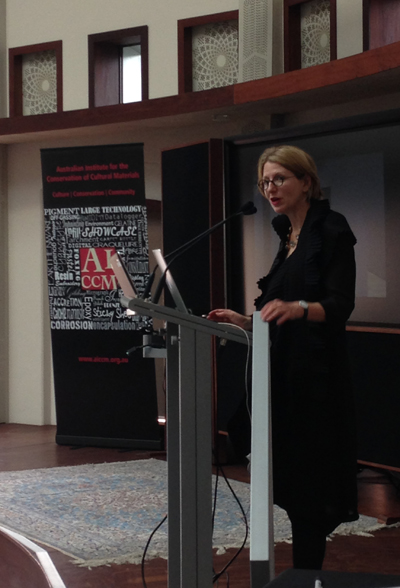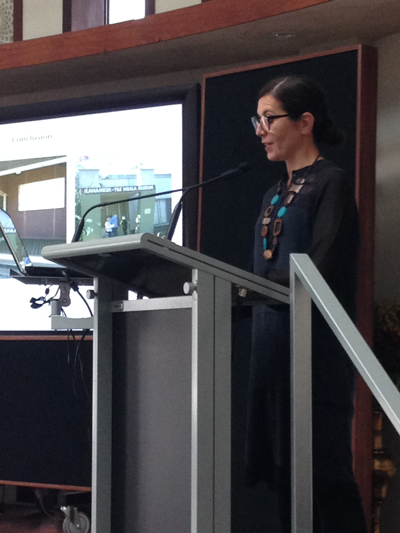The last time that the Tasmanian Division of the AICCM hosted the national conference was in 1990 in Launceston, and what a fabulous job they did 25 years later in Hobart.
One attendee, who had not been to a National Conference before said, “I really enjoyed myself, and I’m going to go to the next conference in 2017 in Sydney!” The theme of the 2015 national conference “Illuminating the new: contemporary practice and issues in materials conservation” was chosen to respect the UNESCO International Year of Light and Light-based Technologies. The Year of Light is a timely recognition of the challenges facing conservators with conference speakers addressing this theme in a variety of ways.
 The keynote speaker was Professor Sarah Kenderdine, Deputy Director of the National Institute for Experimental Arts at the University of New South Wales, and Director of the iGLAM Lab (Laboratory for Innovation in Galleries, Libraries, Archives and Museums). Her research and its implementation is at the forefront of interactive and immersive experiences for museums and galleries. She described examples of life scale digital immersion into cultural sites as well as various forms of interaction where the detail and stories of cultural materials is brought to life. Her advice to conservators is to ensure that documentation is high quality enough to act as a reservoir for future interactive purposes. Apparently iphone photos are not really good enough! In a clever move by the organisers, the keynote address was on the last morning of the conference, meaning that no delegate was disadvantaged by having to speak early in the morning after a glamorous night spent at the AICCM awards night.
The keynote speaker was Professor Sarah Kenderdine, Deputy Director of the National Institute for Experimental Arts at the University of New South Wales, and Director of the iGLAM Lab (Laboratory for Innovation in Galleries, Libraries, Archives and Museums). Her research and its implementation is at the forefront of interactive and immersive experiences for museums and galleries. She described examples of life scale digital immersion into cultural sites as well as various forms of interaction where the detail and stories of cultural materials is brought to life. Her advice to conservators is to ensure that documentation is high quality enough to act as a reservoir for future interactive purposes. Apparently iphone photos are not really good enough! In a clever move by the organisers, the keynote address was on the last morning of the conference, meaning that no delegate was disadvantaged by having to speak early in the morning after a glamorous night spent at the AICCM awards night.
Galleries and museums are collecting an increasing number of time-based media and live art works, presenting challenging technological and ethical conservation issues. The first session of the conference was dedicated to exploring conservation work in this area. Kasi Albert described the evolution of her conservation skillset to include certification in testing and tagging electrical components of artworks – most of which failed her compliance testing. She, and other speakers also described the inefficiency of many collection databases to record the spectrum of time based media components effectively, with corporate memory serving an important role in identifying artworks with electrical components. Claire Tindal has researched 3D printing options for casting fills for losses, and has tested the archival quality of common printed plastics, with some disappointing results for ABS. Brooke Randall and Asti Sherring gave great overviews of two collecting institutions and the state of their time based media collections, each with different strategies for conservation – illustrating that there is more than one way to approach the issue of managing time based materials.
Vicki Humphrey gave a very insightful presentation describing the somewhat random criteria for allowable interaction with artefacts. Also wise and insightful was Colin MacGregor who has recognised changing fashions in collecting and exhibiting. This fashion turn around in fortune is particularly apt in the case of taxidermy specimens. These specimens that were not considered of scientific importance are now valued for their historic and sometimes exotic appeal. Having survived the threat of de-accessioning and prolonged neglect, the unsuspecting object suddenly justifies a concentrated bout of conservation treatment to undo the ravages of B-grade storage. Open display of such specimens was also thread in a number of presentations, with Colin noting that many taxidermy specimens historically photographed on open display at the Australian Museum are no longer in the collection – possibly due to degradation issues. Megan Dean-Jones and Sheldon Teare gave lightning presentations describing treatment of taxidermy specimens for display – joint sessions meant that I missed Sheldon’s longer presentation on the Australian Museum project so I missed out on hearing how the team prepared over 400 specimens for display. Sarah Babister and Danielle Measday from Museum Victoria have also been dealing with maintenance of taxidermy specimens on open display – a 10 year open display – so you can imagine the amount of dust that can accumulate on those fragile feathers and fur, and the difficulty in cleaning.
Taxidermy also came into focus during Rosemary Goodall and Helen Privett’s summary of Museum Victoria’s project to survey hazardous materials in their History and Technology collections, with Rosemary noting that she doesn’t like to eat in food outlets with taxidermy as interior design due to possible heavy metal pesticide residues. She also gave examples of hidden hazards such as polychlorinated biphenyls (PCBs) in electrical equipment that are often sealed in small components and are not visually apparent, and Helen described her work identifying and storing, or otherwise, hazardous pharmaceuticals.
From the land of students, it was interesting to hear that not everyone born after 1985 embraces digital technology. Alison Wain at the University of Canberra described the emphasis on transitioning heritage students from a low level of digital interest and skill to an active role as digital creatives. Similarly, Petronella Nell at University of Melbourne noted that there is a determined effort to develop and promote the use of digital technologies in their postgraduate teaching and research programs.
Environmental standards and risk management were also topics of discussion, with Museum Victoria very active in this area as described by Alice Cannon and Karina Palmer. Unfortunately it seems that one risk or environmental strategy or survey doesn’t necessarily translate from one institution to another, however, presenters are happy to discuss their calculations, statistics, and communication with collection managers with all who are keen. In a similar vein, Denyl Cloughley described the National Library of Australia’s testing of the broadening of parameters, and Lisa Addison described fogging issues in display cases at the National Gallery of Australia.
 Specialty group papers outlining research and treatments were too numerous to run concurrently, and so were split in parallel sessions. This made it difficult to choose where to be for most of day two with many hopping between sessions. As a paintings conservator, I enjoyed seeing the time lapse images of washing a 5m x 8m doona cover for a Ron Mueck artwork by Amanda Pagliarino and Michael Marendy; Damian Lizun’s presentation on conservation of composite boards; Narayan Khandekar‘s nuanced presentation describing collecting and analyzing pre art-centre indigenous pigments; Mar Gomez Lobon describing her anxiety watching Robin Tait wash an historic painted photograph; Cash Brown’s fabulous macro images of paint surfaces of Phillip Wolfhagen; Jocelyn Evans’ careful management of a 40 tonne Arthur Boyd wall painting and Raymonda Rajkowski ‘s beautifully described timelines of synthetic polymer paint uptake by the Field artists. You will have to check out the conference program for details of the other sessions, with many other fabulous papers being delivered showcasing what a talented and determined group of conservators we are.
Specialty group papers outlining research and treatments were too numerous to run concurrently, and so were split in parallel sessions. This made it difficult to choose where to be for most of day two with many hopping between sessions. As a paintings conservator, I enjoyed seeing the time lapse images of washing a 5m x 8m doona cover for a Ron Mueck artwork by Amanda Pagliarino and Michael Marendy; Damian Lizun’s presentation on conservation of composite boards; Narayan Khandekar‘s nuanced presentation describing collecting and analyzing pre art-centre indigenous pigments; Mar Gomez Lobon describing her anxiety watching Robin Tait wash an historic painted photograph; Cash Brown’s fabulous macro images of paint surfaces of Phillip Wolfhagen; Jocelyn Evans’ careful management of a 40 tonne Arthur Boyd wall painting and Raymonda Rajkowski ‘s beautifully described timelines of synthetic polymer paint uptake by the Field artists. You will have to check out the conference program for details of the other sessions, with many other fabulous papers being delivered showcasing what a talented and determined group of conservators we are.
Field trips to Shene historic house, Mawson’s replica huts and Mt Wellington were enjoyed on the second afternoon, with some choosing instead to explore local institutions such as TMAG (where we also met the previous night for tours and welcome drinks) and MONA. Hobart has a lot to offer.
The big picture final day included presentations promoting conservation skills through tools such as digital cleaning of discoloured paintings and engaging community interest in the preservation of ‘ghost signs’ in City of Port Phillip by Nicole Tse. Hakim Abdul Rahim contemplated methods to actively engage communities in collections that may not currently be in fashion. Jessye Wdowin-McGregor spoke about the preservation of live art – an art form that has no material presence – through strategies such embodied memory and re-performance. Samantha Hamilton and Sophie Lewincamp described the difficulties and satisfactions of cultural development projects involving conservation in both remote and aged communities. Extra large big pictures were provided by Julian Bickersteth and Robyn Sloggett who described different parts of the conservation spectrum, but who both recognise that traditional modeling of the conservation profession on collecting institutions is no longer useful, and also that there will always be previously unexplored avenues and resources for managing change in the cultural materials sector.
And we can’t forget the terrific posters illustrating projects as varied as the ethics of reprinting digital photographs in collections (Jodie Scott), the conservation of tower houses in Albania (Jenny O’Connell) and the importance of social media to our lives (Amy Bartlett).
Overall, it was a terrific conference, with almost 150 delegates, food supplied for lunch and most dinners, great drinks and awards functions (except not so great for those who had a bar full of red wine accidentally spilt on their jackets), a diversity of papers and a vey welcoming and insightful profession. Best of all were the almost 40 students who attended, a great turn out and much appreciated by the AICCM for their interest.
We all look forward to the next National Conference in 2017, and especially to see how those new to the profession are realising their interests and how those older (and wiser?) are remaining engaged and excited by materials conservation.